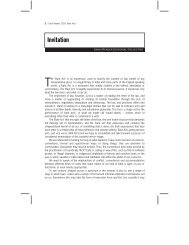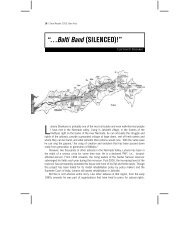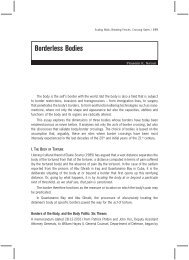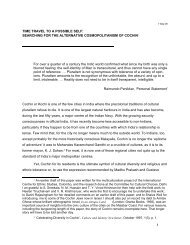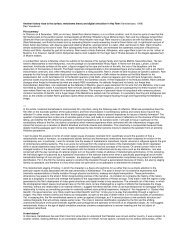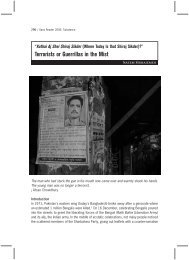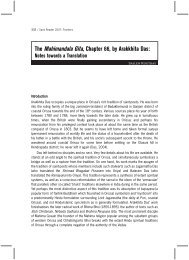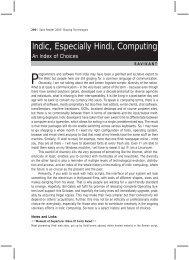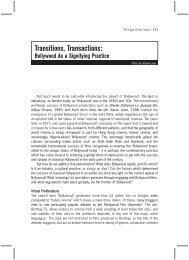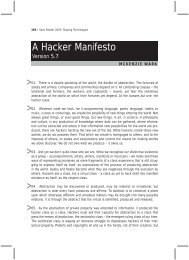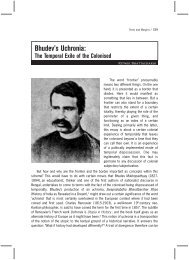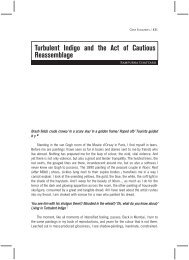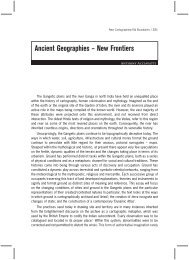You also want an ePaper? Increase the reach of your titles
YUMPU automatically turns print PDFs into web optimized ePapers that Google loves.
260 / <strong>Sarai</strong> Reader 08 : <str<strong>on</strong>g>Fear</str<strong>on</strong>g><br />
Simultaneously, the Ramsay Brothers are entering a trans-c<strong>on</strong>tinental fraternity of ‘B’<br />
cinemas, positi<strong>on</strong>ed syn<strong>on</strong>ymously with such figures as Mario Bava and Georges Franju,<br />
other derogated practiti<strong>on</strong>ers of horror who have been revitalised by globalisati<strong>on</strong>’s enormous<br />
reach and recycling capacities. L<strong>on</strong>g-forgotten as mindless Bombay bilge that wasn’t even<br />
available with pavement hawkers, Purana Mandir is now being disseminated as intellectually<br />
affluent, global ‘trash’ cinema by the M<strong>on</strong>do Macabro DVD series, a glossily packaged “walk<br />
<strong>on</strong> the wild side of Asian Cinema”. The rehabilitati<strong>on</strong>, however, has l<strong>on</strong>g roots, discernible in<br />
two divergent reviews of Purana Mandir that appeared in the year after its release. <strong>Film</strong>fare,<br />
India’s top-selling film magazine, had given the movie a pass in its opening weeks; in January<br />
1985, however, testifying to Purana Mandir’s box office muscularity, the magazine gave its<br />
top critic, Pritish Nandy, a whole two pages to review it. Titled “Indiana J<strong>on</strong>es Returns to<br />
the Temple of Gloom” (<strong>Film</strong>fare, 1-15 January 1985), Nandy’s piece is an exercise in brutal<br />
belittlement. His observati<strong>on</strong>s are usually unkind (“the cardboard walls are falling off”), sometimes<br />
lazy (the repeated reference to the movie’s m<strong>on</strong>ster as Shaitan; his name is Samri),<br />
and often unverifiable (“The results are predictable… Every<strong>on</strong>e wants the gate m<strong>on</strong>ey back,<br />
while the ushers hide under the chairs”). Failing to menti<strong>on</strong> even <strong>on</strong>ce that the film was a<br />
gargantuan success <strong>on</strong> any scale, the review c<strong>on</strong>cludes thus:<br />
One cannot but help admiring the sensitivity and intelligence with which this film<br />
has been made. It speaks volumes for Hindi cinema and the Ramsays, our horror<br />
movie moghuls, who have (with this film) graduated towards serious, thoughtprovoking<br />
cinema of a kind rarely seen before. (Nandy, 1985)<br />
Six m<strong>on</strong>ths after Nandy’s review, another critic with <strong>Film</strong>fare was also given two pages for an<br />
article <strong>on</strong> the Ramsays. In “Love at First Bite” (<strong>Film</strong>fare, 1-15 August 1985), Roscoe Mend<strong>on</strong>za<br />
expressed boundless hope that a future re-evaluati<strong>on</strong> would show the Brothers to have been<br />
auteurs. Mend<strong>on</strong>za’s article is a half-winking, implicit but obvious rebuttal to Nandy’s:<br />
We need such films. It may be fine for Mrinal Sen or Saeed Mirza to trumpet the<br />
ways and means in which their movies serve the needs of society. Likewise, the<br />
dukes of commercial cinema, who tout the need for entertainment in a weary<br />
society. But can either of these two cliques bring to their film-making a true understanding<br />
of the Indian Psyche the way Ramsay brothers have? (Mend<strong>on</strong>za, 1985)<br />
Horror, writes Joan Hawkins, “is perhaps the best vantage point from which to study the<br />
cracks that seem to exist everywhere in late-20th century ‘sacralised’ film culture” (Hawkins,<br />
2000). Purana Mandir, as it passed through the press mill, turned the pages of <strong>Film</strong>fare into<br />
a cultural war-z<strong>on</strong>e. In hindsight, it seems perversely appropriate that the Ramsays rose to<br />
prominence in the 70s, a period lit by the promises of the Indian New Wave and scorched<br />
by the anger of Amitabh Bachchan, and scored their biggest hits in the 80s, the decisive<br />
abyss of Bombay film history, a terrible time that produced few other memorable victories.



